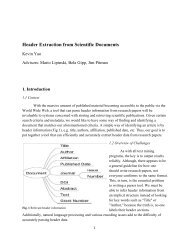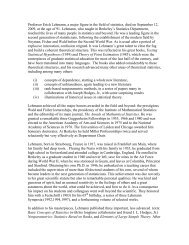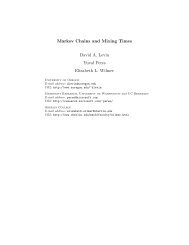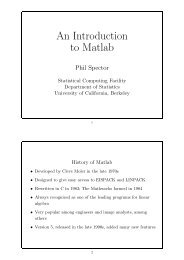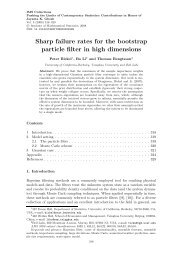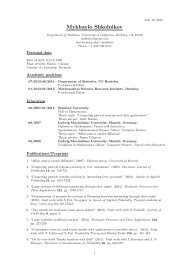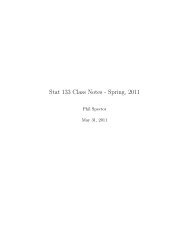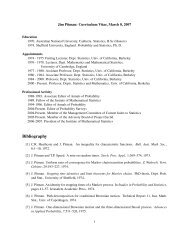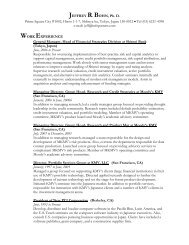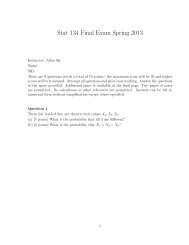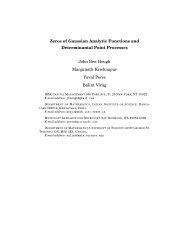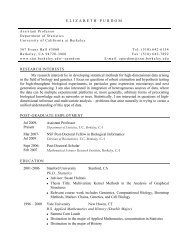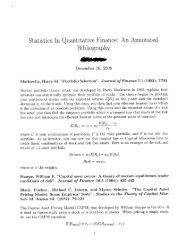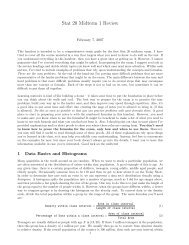Lecture 3: The Voter Model
Lecture 3: The Voter Model
Lecture 3: The Voter Model
Create successful ePaper yourself
Turn your PDF publications into a flip-book with our unique Google optimized e-Paper software.
3. <strong>The</strong> <strong>Voter</strong> <strong>Model</strong><br />
David Aldous<br />
July 22, 2012
We now move on to the voter model, which (compared to the averaging<br />
model) has a more substantial literature in the finite setting, so what’s<br />
written here is far from complete. It would be a valuable project for<br />
someone to write a (50-page?) survey article.<br />
Here the update rule has a random (fair coin flip) component. Nicest to<br />
implement this within the meeting model via a “directed” convention:<br />
when agents i, j meet, choose a random direction and indicate it using an<br />
arrow i → j or j → i.
<strong>Voter</strong> model. Initially each agent has a different “opinion” – agent i has<br />
opinion i. When i and j meet at time t with direction i → j, then agent j<br />
adopts the current opinion of agent i.<br />
So we can study<br />
V i (t) := the set of j who have opinion i at time t.<br />
Note that V i (t) may be empty, or may be non-empty but not contain i.<br />
<strong>The</strong> number of different remaining opinions can only decrease with time.<br />
Minor comments. (i) We can rephrase the rule as “agent i imposes his<br />
opinion on agent j”.<br />
(ii) <strong>The</strong> name is very badly chosen – people do not vote by changing their<br />
minds in any simple random way.
Nuance. In the classical, infinite lattice, setting one traditionally<br />
assumed only two different initial opinions. In our finite-agent case it<br />
seems more natural to take the initial opinions to be all different.<br />
Ultimate behavior is obvious (cf. General Principle 1): absorbed in one of<br />
the n “everyone has same opinion” configurations.<br />
Note that one can treat the finite and infinite cases consistently by using<br />
IID U(0,1) opinion labels.<br />
So {V i (t), i ∈ Agents} is a random partition of Agents. A natural<br />
quantity of interest is the consensus time<br />
T voter := min{t : V i (t) = Agents for some i}.
Coalescing MC model. Initially each agent has a token – agent i has<br />
token i. At time t each agent i has a (maybe empty) collection (cluster)<br />
C i (t) of tokens. When i and j meet at time t with direction i → j, then<br />
agent i gives his tokens to agent j; that is,<br />
C j (t+) = C j (t−) ∪ C i (t−), C i (t+) = ∅.<br />
Now {C i (t), i ∈ Agents} is a random partition of Agents. A natural<br />
quantity of interest is the coalescence time<br />
T coal := min{t : C i (t) = Agents for some i}.<br />
Minor comments. Regarding each non-empty cluster as a particle, each<br />
particle moves as the MC at half-speed (rates ν ij /2), moving independently<br />
until two particles meet and thereby coalesce. Note this factor 1/2 in this<br />
section.
For fixed t,<br />
<strong>The</strong> duality relationship.<br />
{V i (t), i ∈ Agents} d = {C i (t), i ∈ Agents}.<br />
In particular T voter d<br />
= T coal .<br />
<strong>The</strong>y are different as processes. For fixed i, note that |V i (t)| can only<br />
change by ±1, but |C i (t)| jumps to and from 0.<br />
In figures on next slides,<br />
time “left-to-right” gives CMC,<br />
time “right-to-left” with reversed arrows gives VM.<br />
Note this depends on the symmetry assumption ν ij = ν ji of the meeting<br />
process.
Schematic – the meeting model on the 8-cycle.<br />
0=8 <br />
✻<br />
7 ❄<br />
❄ ❄<br />
✻<br />
✻<br />
6 <br />
❄<br />
❄<br />
✻ ✻<br />
5 ❄ ❄<br />
✻<br />
✻<br />
4 ❄<br />
❄<br />
✻ ✻<br />
3 <br />
❄ ❄ ❄<br />
✻<br />
2 <br />
❄ ❄<br />
✻<br />
✻<br />
1 ❄ ❄ ❄<br />
0 ❄ ❄❄ ✻
0<br />
1<br />
2<br />
3<br />
4<br />
5<br />
6<br />
7<br />
0=8<br />
✻<br />
✻<br />
❄<br />
✻<br />
✻<br />
❄<br />
❄<br />
❄<br />
❄<br />
❄<br />
❄<br />
❄<br />
✻<br />
❄<br />
❄<br />
❄<br />
✻<br />
✻<br />
❄<br />
❄ ❄ ✻<br />
✻<br />
❄<br />
✻<br />
❄<br />
✻<br />
❄<br />
✻<br />
❄<br />
✻<br />
❄<br />
❄
0=8 <br />
7 ❄<br />
❄<br />
✻<br />
✻<br />
6 <br />
❄<br />
❄C 6 (t) = {0, 1, 2, 6, 7}<br />
✻<br />
5 <br />
❄<br />
✻<br />
4 ❄<br />
V 2 (t) = {3, 4, 5} ✻<br />
3 <br />
❄<br />
2 <br />
❄ C 2 (t) = {3, 4, 5}<br />
✻<br />
✻<br />
1 ❄ ❄ ❄<br />
0 <br />
❄
Literature on finite voter model has focussed on estimating<br />
T voter d<br />
= T coal , and I will show some of this work.<br />
But there are several other questions one can ask about the finite-time<br />
behavior . . . . . .
<strong>Voter</strong> model on the complete graph<br />
<strong>The</strong>re are two ways to analyze Tn<br />
voter on the complete graph, both<br />
providing some bounds on other geometries.<br />
Part of Kingman’s coalescent is the continuous-time MC on states<br />
{1, 2, 3, . . .} with rates λ k,k−1 = ( k<br />
2)<br />
, k ≥ 2. For that chain<br />
E m T hit<br />
1 =<br />
m∑<br />
( k<br />
1/ = 2(1 −<br />
2)<br />
1 m )<br />
k=2<br />
and in particular lim m→∞ E m T hit<br />
1 = 2.<br />
In coalescing RW on the complete n-graph, the number of clusters<br />
evolves as the continuous-time MC on states {1, 2, 3, . . . , n} with rates<br />
λ k,k−1 =<br />
n−1( 1 k<br />
)<br />
2 . So ET<br />
coal<br />
n = (n − 1) × 2(1 − 1 n<br />
) and in particular<br />
ET voter<br />
n<br />
= ET coal<br />
n ∼ 2n. (1)
<strong>The</strong> second way is to consider the variant of the voter model with only 2<br />
opinions, and to study the number X (t) of agents with the first opinion.<br />
On the complete n-graph, X (t) evolves as the continuous-time MC on<br />
states {0, 1, 2, . . . , n} with rates<br />
λ k,k+1 = λ k,k−1 = k(n−k)<br />
2(n−1) .<br />
This process arises in classical applied probability (e.g. as the Moran<br />
model in population genetics). We want to study<br />
T hit<br />
0,n := min{t : X (t) = 0 or n}.<br />
By general birth-and-death formulas, or by comparison with simple RW,<br />
E k T hit<br />
0,n = 2(n−1)<br />
n<br />
(k(h n−1 − h k+1 ) + (n − k)(h n−1 − h n−k+1 ))<br />
where h m := ∑ m<br />
i=1<br />
1/i. This is maximized by k = ⌊n/2⌋, and<br />
max E k T0,n hit ∼ (2 log 2) n.<br />
k
Now we can couple the true voter model (n different initial opinions)<br />
with the variant with only 2 opinions, initially held by k and n − k<br />
agents. (Just randomly assign these two opinions, initially). From this<br />
coupling we see<br />
P k (T0,n hit > t) ≤ P(Tn voter > t)<br />
P k (T0,n hit > t) ≥ 2k(n−k−1) P(Tn voter > t)<br />
n(n−1)<br />
In particular, the latter with k = ⌊n/2⌋ implies<br />
ET voter<br />
n ≤ (4 log 2 + o(1)) n.<br />
This is weaker than the correct asymptotics (1).
<strong>Voter</strong> model on general geometry<br />
Suppose the flow rates satisfy, for some constant κ,<br />
ν(A, A c ) :=<br />
∑<br />
i∈A,j∈A c n −1 ν ij ≥ κ<br />
|A|(n − |A|)<br />
.<br />
n(n − 1)<br />
On the complete graph this holds with κ = 1. We can repeat the analysis<br />
above – the process X (t) now moves at least κ times as fast as on the<br />
complete graph, and so<br />
ET voter<br />
n<br />
≤ (4 log 2 + o(1)) n/κ.<br />
This illustrates another general principle.
General Principle 4: Bottleneck statistics give crude general bounds<br />
For a geometry with given rate matrix N = (ν ij ), the quantity<br />
ν(A, A c ) =<br />
∑<br />
n −1 ν ij<br />
i∈A,j∈A c<br />
has the interpretation, in terms of the associated continuous-time Markov<br />
chain Z(t) at stationarity, as “flow rate” from A to A c<br />
So if for some m the quantity<br />
P(Z(0) ∈ A, Z(dt) ∈ A c ) = ν(A, A c ) dt.<br />
φ(m) = min{ν(A, A c ) : |A| = m}, 1 ≤ m ≤ n − 1<br />
is small, it indicates a possible “bottleneck” subset of size m.<br />
For many FMIE models, one can obtain upper bounds (on the expected<br />
time until something desirable happens) in terms of the parameters<br />
(φ(m), 1 ≤ m ≤ n/2). Such bounds are always worth noting, though<br />
φ(m) is not readily computable, or simulate-able<br />
<strong>The</strong> bounds are often rather crude for a specific geometry
More elegant to combine the family (φ(m), 1 ≤ m ≤ n/2) into a single<br />
parameter, but the appropriate way to do this is (FMIE)<br />
model-dependent. In the voter model case above we used the parameter<br />
n(n − 1)ν(A, A c )<br />
φ(m)<br />
κ := min<br />
= n(n − 1) min<br />
A |A|(n − |A|)<br />
m m(n − m) .<br />
Quantities like κ are descriptive statistics of a weighted graph. In<br />
literature you see the phrase “isoperimetric inequalities” which refers to<br />
bounds for particular weighted graph. In our setting – bounding behavior<br />
of a particular FMIE process in terms of the geometry – ”bottleneck<br />
statistics” seems a better name.
Digression: regularity conditions for finite irreducible MCs<br />
Degrees of freedom<br />
general n(n − 1)<br />
1<br />
reversible, π general<br />
2n(n − 1) + (n − 1)<br />
reversible, π uniform 1 2n(n − 1)<br />
vertex-transitive n − 1<br />
A cute fact about general MCs is<br />
∑<br />
π j E i Tj hit := τ 0<br />
j<br />
does not depend on i, and is the natural “ave hitting time” statistic for a<br />
MC.
Coalescing MC on general geometry<br />
Issues clearly related to study of the meeting time Tij<br />
meet of two<br />
independent copies of the MC, a topic that arises in other contexts.<br />
Under enough symmetry (e.g. continuous-time RW on the discrete torus)<br />
the relative displacement between the two copies evolves as the same RW<br />
run at twice the speed, and study of Tij<br />
meet reduces to study of Tk hit.<br />
First consider the general reversible case. In terms of the associated MC<br />
define a parameter<br />
τ ∗ := max E i Tj hit .<br />
i,j<br />
<strong>The</strong> following result was conjectured long ago but only recently proved.<br />
Proof is intricate.<br />
<strong>The</strong>orem (Oliveira 2010)<br />
<strong>The</strong>re exist numerical constants C 1 , C 2 < ∞ such that, for any finite<br />
irreducible reversible MC, max i,j ET meet<br />
ij ≤ C 1 τ ∗ and ET coal ≤ C 2 τ ∗ .<br />
In our meeting model setting of uniform stationary distribution this<br />
typically gives us the correct order of magnitude of ET coal = ET voter .
To seek “1 ± o(1)” limits, that is to generalize the Kngman coalescent<br />
result, write τ meet for mean meeting time from independent uniform<br />
starts. In a sequence of chains with n → ∞, impose a condition such as<br />
the following. For each ε > 0<br />
n −2 |{(i, j) : ET meet<br />
ij ∉ (1 ± ε)τ meet }| → 0. (2)<br />
Open problem. Assuming (2), under what further conditions can we<br />
prove ET coal ∼ 2τ meet ?<br />
This project splits into two parts.<br />
Part 1. For fixed m, show that the mean time for m initially independent<br />
uniform walkers to coalesce should be ∼ 2(1 − 1 m )τ meet.<br />
Part 2. Show that for m(n) → ∞ slowly, the time for the initial n<br />
walkers to coalesce into m(n) clusters is o(τ meet ).<br />
Part 1 is essentially a consequence of known results, as follows.
From old results on mixing times (RWG section 4.3), a condition like (2)<br />
is enough to show that the (variation distance) mixing time<br />
τ mix = o(τ meet ). So – as a prototype use of τ mix – by considering time<br />
intervals of length τ, for τ mix ≪ τ ≪ τ meet , the events “a particular pair<br />
of walker meets in the next τ-interval” are approximately independent.<br />
This makes the “number of clusters” process behave as the Kingman<br />
coalescent.<br />
Note. That is the hack proof. Alternatively, the explicit bound involving τ rel on<br />
exponential approximation for hitting time distributions from stationarity is<br />
applicable to the meeting time of two walkers, so a more elegant way would be<br />
to find an extension of that result applicable to the case involving m walkers.<br />
Part 2 needs some different idea/assumptions to control short-time<br />
behavior.
(restate) Open problem. Assuming (2), under what further conditions<br />
can we prove ET coal ∼ 2τ meet ?<br />
What is known rigorously?<br />
Cox (1989) proves this for the torus [0, m − 1] d in dimension d ≥ 2. Here<br />
τ meet = τ hit ∼ m d R d for d ≥ 3.<br />
Cooper-Elsässer-Ono-Radzik (2012) prove (essentially)<br />
ET coal = O(n/λ)<br />
where λ is the spectral gap of the associated MC. But this bound is of<br />
correct order only for expander-like graphs.
(repeat earlier slide)<br />
Literature on finite voter model has focussed on estimating<br />
T voter d<br />
= T coal , and I have shown some of this work.<br />
But there are several other questions one can ask about the finite-time<br />
behavior. Let’s recall what we studied for the averaging process.
(repeat earlier slide: averaging process)<br />
If the initial configuration is a probability distribution (i.e. unit<br />
money split unevenly between individuals) then the vector of<br />
expectations in the averaging process evolves precisely as the<br />
probability distribution of the associated (continuous-time) Markov<br />
chain with that initial distribution<br />
<strong>The</strong>re is a duality relationship with coupled Markov chains<br />
<strong>The</strong>re is an explicit bound on the closeness of the time-t<br />
configuration to the limit constant configuration<br />
Complementary to this global bound there is a “universal” (i.e. not<br />
depending on the meeting rates) bound for an appropriately defined<br />
local roughness of the time-t configuration<br />
<strong>The</strong> entropy bound.
Other aspects of finite-time behavior (voter model)<br />
1. <strong>The</strong> voter model has a simple “geometry-invariant” property:<br />
expected total number of opinion changes = n(n − 1).<br />
This holds because “number of agents with opinion i” is a martingale.<br />
2. If the proportions of agents with the various opinions are written as<br />
x = (x i ), the statistic q := ∑ i x i 2 is one measure of concentration -<br />
diversity of opinion. So study Q(t) := ∑ i (n−1 |V i (t)|) 2 . Duality implies<br />
EQ(t) = P(T meet ≤ t)<br />
where T meet is meeting time for independent MCs with uniform starts.<br />
Can study in special geometries.<br />
3. A corresponding “local” measure of concentration - diversity is the<br />
probability that agents (I , J) chosen with probability ∝ ν ij (“neighbors”)<br />
have same opinion at t. (“Diffusive clustering”: Cox (1986)). Can again<br />
study by duality.
4. <strong>The</strong> diversity statistic q := ∑ i x i<br />
2 emphasizes large clusters (large<br />
time); the statistic ent(x) = − ∑ i x i log x i emphasizes small clusters<br />
(small time). So one could consider<br />
E(t) := − ∑ i<br />
(n −1 |V i (t)|) log(n −1 |V i (t)|)<br />
Apparently not studied – involves similar short-time issues as in the<br />
ET coal ∼ 2τ meet ? question.
General Principle 5: Approximating finite graphs by infinite graphs<br />
For two of the standard geometries, there are local limits as n → ∞.<br />
• For the torus Z d m, the m → ∞ limit is the infinite lattice Z d .<br />
• For the “random graphs with prescribed degree distribution” model,<br />
the limit is the associated Galton-Watson tree.<br />
<strong>The</strong>re is also a more elaborate random network model (Aldous 2004)<br />
designed to have a more “interesting” local weak limit for which one can<br />
do some explicit calculations – it’s an Open Topic to use this as a<br />
testbed geometry for studying FMIE processes.<br />
So one can attempt to relate the behavior of a FMIE process on such a<br />
finite geometry to its behavior on the infinite geometry. This is simplest<br />
for the “epidemic” (FPP) type models later, but also can be used for<br />
MC-related models, starting from the following
Local transience principle. For a large finite-state MC whose behavior<br />
near a state i can be approximated be a transient infinite-state chain, we<br />
have<br />
E π Ti<br />
hit ≈ R i /π i<br />
∫where R i is defined in terms of the approximating infinite-state chain as<br />
∞<br />
p<br />
0 ii (t) dt = 1<br />
ν i q i<br />
, where q i is the chance the infinite-state chain started<br />
at i will never return to i.<br />
<strong>The</strong> approximation comes from the finite-state mean hitting time formula<br />
via a “interchange of limits” procedure which requires ad hoc<br />
justification.<br />
Conceptual point here: local transience corresponds roughly to voter<br />
model consensus time being Θ(n) (as seen in the Z d case).
In the case of simple RW on the d ≥ 3-dimensional torus Z d m, so n = m d ,<br />
this identifies the limit constant in E π Ti<br />
hit ∼ R d n as R d = 1/q d where q d<br />
is the chance that RW on the infinite lattice Z d never returns to the<br />
origin.<br />
In the “random graphs with prescribed degree distribution” model, this<br />
argument (and transience of RW on the infinite Galton-Watson limit<br />
tree) shows that E π Ti<br />
hit = Θ(n)
A final thought<br />
We have seen that the behaviors of the Averaging Process/ <strong>Voter</strong> <strong>Model</strong><br />
are closely related to the mixing/hitting behavior of the associated MC.<br />
For Markov chains, mixing times and hitting times are “basic” objects of<br />
study in both theory and applications. <strong>The</strong>y are not directly related to<br />
each other, but Aldous (1981) showed some indirect connections, and in<br />
particular an improvement by Peres-Sousi (2012) shows that (variation<br />
distance) mixing time for a reversible chain agrees (up to constants) with<br />
max A:π(A)≥1/4 max i E i T hit<br />
A .<br />
Is there any indirect connections between properties of the Averaging<br />
Process/<strong>Voter</strong> <strong>Model</strong>? Does the natural coupling tell you anything?<br />
Bathtub problem. Invent models which combine Averaging<br />
Process/<strong>Voter</strong> <strong>Model</strong>. (I will mention two in lecture 5).



